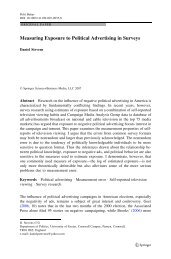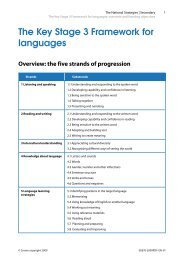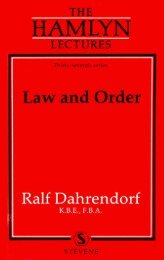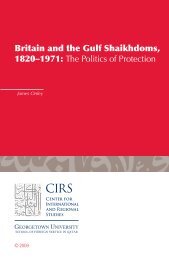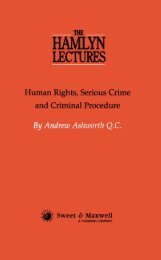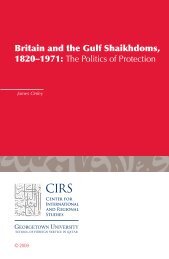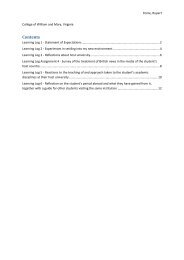Blackstone's Tower: The English Law School - College of Social ...
Blackstone's Tower: The English Law School - College of Social ...
Blackstone's Tower: The English Law School - College of Social ...
Create successful ePaper yourself
Turn your PDF publications into a flip-book with our unique Google optimized e-Paper software.
<strong>The</strong> <strong>Law</strong> Library<br />
"<strong>The</strong> answer, from the Editor <strong>of</strong> <strong>The</strong> <strong>Law</strong> Quarterly Review, accepted<br />
in general by those present, was that a journal should not only be a<br />
medium <strong>of</strong> reportage but had a wider duty to legal scholarship and to<br />
the development <strong>of</strong> the law itself. It should provide a body <strong>of</strong> comment,<br />
analysis and criticism <strong>of</strong> the law, pointing out flaws, anomalies and<br />
longstanding misapprehensions. This criticism should embrace not only<br />
statutes and decisions but also books and even other journals." 54<br />
It would be tempting to analyse the assumptions about legal scholarship<br />
and writing underlying this view, and to speculate whether<br />
this would reflect a consensus today. <strong>The</strong> <strong>Law</strong> Quarterly Review<br />
is one <strong>of</strong> the few academic journals that is regularly read by judges<br />
and other senior members <strong>of</strong> the legal establishment. It seeks to<br />
influence legal opinion as well as to be a vehicle for high quality<br />
scholarly writing, mainly <strong>of</strong> a fairly traditional kind. Volume 109<br />
for 1993 conforms fairly closely to the model <strong>of</strong> comment, analysis<br />
and criticism <strong>of</strong> law, suggested by the former editor. <strong>The</strong>re were 19<br />
articles, about 14 <strong>of</strong> which could be said to be scholarly analyses <strong>of</strong><br />
contemporary legal doctrine. Two articles were by senior judges.<br />
<strong>The</strong>re were over 60 notes, almost all <strong>of</strong> which were analytical,<br />
reflective, sometimes critical comments on recent reported cases.<br />
<strong>The</strong> <strong>Law</strong> Quarterly Review and other similar journals also comment<br />
fairly regularly on recent legislation and on important public<br />
reports, especially those relating to law reform. This volume also<br />
included reviews <strong>of</strong> 26 books. Most <strong>of</strong> the reviewers and authors<br />
were legal academics.<br />
While the <strong>Law</strong> Quarterly has been influential on the form and<br />
style <strong>of</strong> other leading academic law journals, each has its own editorial<br />
policy and distinguishing characteristics. Few so consistently<br />
seek to bridge the academic/pr<strong>of</strong>essional divide. Some are more<br />
commitedly theoretical, some are more polemical, and a few are<br />
consciously outlets for sociolegal or "critical" or other nontraditional<br />
perspectives. By and large, despite the economic climate,<br />
they have kept pace with the increase in the number <strong>of</strong> producers<br />
and the diversification <strong>of</strong> legal scholarship. In law, it is not<br />
too difficult to get published; it may not be so easy to get read.<br />
OTHER LEGAL LITERATURE:<br />
INCLUSIONS AND OMISSIONS<br />
It is revealing that the Bodleian <strong>Law</strong> Library guide <strong>of</strong> 20 years<br />
ago only included textbooks and periodicals as the main categories<br />
<strong>of</strong> secondary literature <strong>of</strong> the United Kingdom. In 1974, Jurispru-<br />
111







